Winter Audio Reference: On-Board, Consumer, and Pro Solutions
by Derek Wilson on February 3, 2005 12:05 AM EST- Posted in
- Smartphones
- Mobile
The Cards
These are the first cards that we'll be taking a look at in their categories. Other sound hardware reviews that we do will have a point of reference to this article. For onboard solutions, we'll compare against the Realtek HD audio that we're reviewing today. When we look at consumer level add-in cards, the obvious metric is the Sound Blaster Audigy 2. For professional cards, we've chosen the Echo Audio Gina3g as our point of reference for its mix of features and solid quality.
The Intel, Gina3G, and Creative mix touches on high quality, integrated, multitrack/music recording, gaming, and the consumer audio solutions. We wanted to hit all these groups in this review in order to get a feel for what each had to offer. The first solution that we'll look at is the Intel solution.
Realtek Intel HD Audio
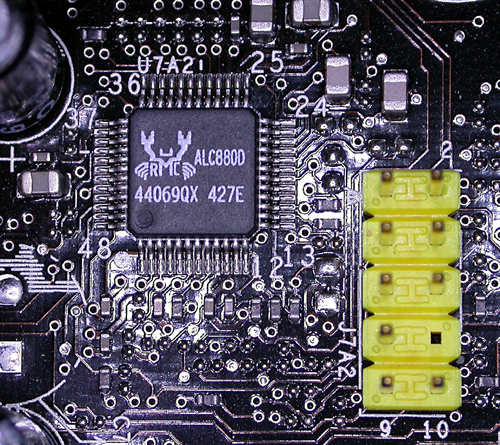
This is the Realtek Intel HD Audio codec chip.
As we can see, the Intel solution is the Realtek solution. We wanted to track down the DACs and opamps that drive the output, but finding these tiny chips on a motherboard proved too difficult a task for us. Suffice it to say that layout is key when dealing with an onboard solution. We actually plugged our Audigy in a PCI port further away from the video card, thinking we'd get better signal quality and noticed an 8dB increase in noise due to this:
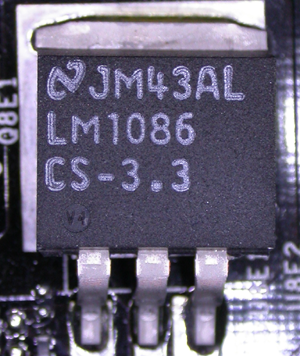
This is a 1.5A low dropout positive regulator near the 3rd PCI slot on the 925XE board.
Imagine the difficulty in guarding against noise with an onboard solution if simply moving to a different PCI slot can change so much. Vendors other than Realtek are planning on coming out with HD audio compatible onboard solutions, and we are looking forward to testing those as well.
On the downside, the Realtek only has 20 bit stereo inputs, so doing a 24bit loopback is a little less than honest. The record quality of this onboard solution is less than optimal, and in very loud playback, a little noise can be heard.
Echo Audio Gina3G
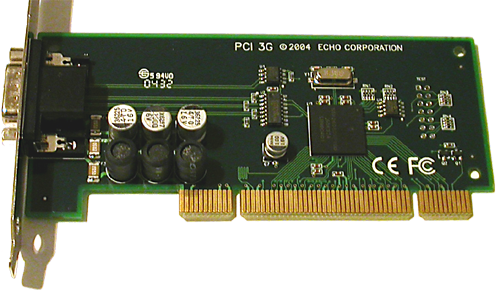
The Gina3G PCI card
The Gina3g is an entry level professional sound card from Echo Audio. Musicians on a budget are always on the lookout for a device that combines a few high quality analog inputs with a couple of coax and optical digital connections that support S/PDIF and ADAT I/O.
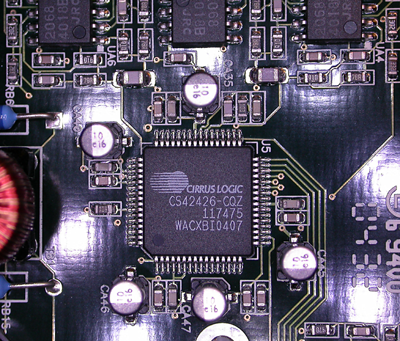
Inside the Gina3G breakout Box
This device would be a stop off on the way to something like the Lynx TwoB, or a DigiDesign ProTools solution. With the ability to record 8 digital channels at a time, 6 (highly configurable, balanced) analog outputs, and 2 universal analog inputs (accepts ¼ inch and XLR, balanced or unbalanced, and can provide 48v of phantom power), the Gina3g is targeted squarely at the end user looking to take their audio and put it on the PC. A small home studio could go the way of having a couple of rack mount devices - compressors, eqs, and an A/D - to bundle it all up and send it to the PC. The Gina would fit in nicely. There are both cheaper and more expensive solutions out there.
In any case, the reason why we are testing the Gina3g today is because its older siblings have done very well traditionally in terms of analog signal quality. We wanted to find out if Echo Audio's latest in the series still stacks up.
Creative SoundBlaster Audigy 2 ZS Platinum Pro
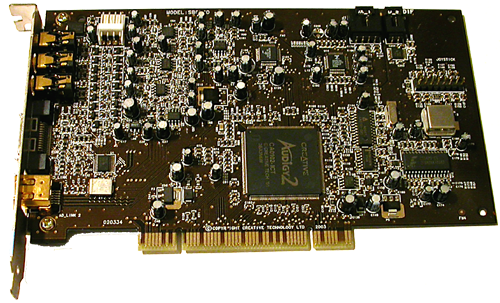
SoundBlaster Audigy 2 ZS Platinum Pro PCI Card
The Audigy is the consumer standard in sound hardware today. It is a very gamer and entertainment PC oriented solution. The Platinum Pro is a Swiss army knife of a sound card - a little of everything, but never exactly what you want. Digital playback is quality, but analog at 16-bit/44.1 kHz leaves something to be desired. Recording quality is solid, but there could be more I/O on the device if it is going to fit into any aggressive user's workflow. Lacking balanced analog I/O is a large oversight if Creative wanted to target the prosumer/audiophile. But in the end, the audigy does fit into just about every niche in which you could want a sound card. And it offers EAX Advanced HD as only Creative cards can.
Creative SoundBlaster Audigy 4 Pro
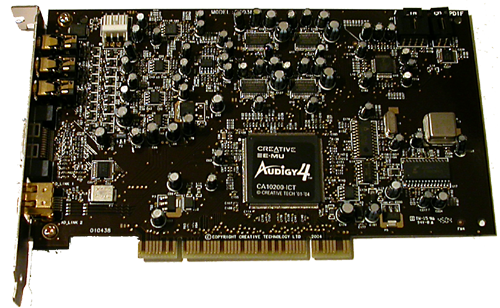
SoundBlaster Audigy 4 Pro
The SoundBlaster Audigy 4 Pro is basically an upgraded and massaged version of the Audigy 2 ZS Platinum Pro. The differences are in the quality of the DACs and ADCs used, some layout changes, and just a bit of a polish that makes the quality of the card fit the feature set better. Still offering the same gaming quality, the analog output of the card is now on par with professional level cards in some respects.
Summarizing the Differences
So, what are the key factors that are different among the contenders? Let's take a look:
-- DAC quality: the Audigy 4 has the highest quality DACs, though the Gina3G places it's DACs outside the PC in its breakout box. Here are the DACs used on the Audigy and Gina3G:
Audigy 2 DAC: 1x CS4382: 8out 114dB dynamic range, -100dB THD+N
Audigy 4 DAC: 4x CS4398: 2out 120dB dynamic range, -107dB THD+N
Gina3G DAC: 1x CS42426: 2in/6out 114dB dynamic range, -100dB THD+N
Both Audigy products use 4558c opamps with THD < .008%
Gina3G uses NJM2068 opamps with THD < .001%
-- Input quality: The Gina3G uses balanced I/O, and has the most input options. The quality of the ADCs on the Gina3G and Audigy are similar (Audigy is noisier with less THD). The Intel Audio solution only supports recording at a max of 20-bit/96kHz analog, and is noisy on recording. No pro digital recording features are enabled on the onboard solution even when lightpipe is present, so Creative and Echo have the Intel beat in digital recording as well.
-- Gaming features: The Creative solutions offer EAX 4.0 Advanced HD, which neither of the other cards can claim. Intel is able to include EAX 2.0 support along side it's DS3D and A3D support, but the Gina3G offers zero 3D hardware support or reverb API support. Included on the Gina3G is a DSP that is capable of such operations (Xilinx Spartan), but it's obviously intended for professional applications.
Other than that, the differences are in feature set and drivers. The Audigy cards offer the most in terms of "stuff" with their cards, though the Intel solution does a good job of filling in the gaps as well. Even though the Gina3G "only" supports 6-channel out on the consumer side, the fact that all 6 outputs are balanced TRS ¼ inch is a nice bonus for the musician. Depending on implementation, the Realtek solution can have optical and coax output, but Audigy and Gina3G both offer optical and coax in and out.










89 Comments
View All Comments
KingofL337 - Friday, February 4, 2005 - link
All, I want is a review of a sound card that does realtime SPDIF DTS/DD encoding not just a card that only does it in DVD's. You find one and I'm gonna go buy it.leliel - Friday, February 4, 2005 - link
i'm still using philips seismic edges (philips tbird avenger chipset, PSC705 model) in my boxen because creative can't put out a decent product. i wouldn't mind seeing the new ultimate edge (PSC724) or aurilium (PSC8xx) reviewed. happy with what i have except the latest drivers for these things are about three years old and games like WoW and republic commando aren't happy with them =PEddNog - Friday, February 4, 2005 - link
MrMarbles; check out the card I have, Echo Audio Mia MIDI. Its sample rate is completely controllable, including full lock to 44.1, with zero resample as long as you bypass Kmixer by either using any of the time critical transports (for example, kernel streaming) or even a special proprietary Kmixer bypass for regular wave audio output that's included in the drivers called Purewave. When I bought it, you could find the card for just $200, and it was over a year ago.-Ed
MrMarbles - Friday, February 4, 2005 - link
I'm interested in buying a soundcard for playing back highquality (if you can call MP3's that) MP3 files. I got an Audigy2 now. Very happy with the low distortion, has a very clean sound on my B&W Nautilus 805 speakers. But, they also have a very wellknown problem with 44.1khz 16bit stereo playback. So looking to upgrade. I'm a bit of a audiophile, but I can't spend too much. Gaming is not something do a lot of anymore.Pandamonium - Friday, February 4, 2005 - link
Missing chipsets:Envy 24HT
nVidia Sounstorm
Maleficus - Thursday, February 3, 2005 - link
THANK YOU, seeing audio on the front page again is AWESOME.LocutusX - Thursday, February 3, 2005 - link
Oh, and the ALC850 is pretty horrible. I used a TB Santa Cruz from 2001 to 2004 (3 years) and noticed the difference straight away when I switched to the on-board sound on my new Athlon64 rig.Later, when I bought an Audigy 2 ZS for Xmas, I noticed the difference on that the moment I popped the card in. Nah, don't waste your time on an ALC850 when there are more worthy things to review;
- VIA Envy24HT cards
- the various Audiophile-ish stuff already mentioned
LocutusX - Thursday, February 3, 2005 - link
From what I've read @ Hydrogenaudio, it's impossible to "bypass" the resample stage with an Audigy 2 ZS (when dealing with 44.1KHz source).Someone posted a wave file which contained a particular sine wave. When played back on hardware which could natively handle 44.1KHz, it sounds fine.
When played back on hardware which resamples 44.1KHz to 48KHz, lots of weird distortion could be heard - sirens, alien noises, etc. On the Audigy 2 ZS, even if you used ASIO or Kernel Streaming output, this behaviour was observed. Only when you did a high quality (SSRC) resample to 48KHz did it sound fine.
BTW I don't see the point in reviewing the TB Santa Cruz. While a good card for its time, that was more than 2 years ago. It's been EOL (end of life) for 2 years now, and there won't be any new drivers made for it. It won't work in future OS's (XP64) and even the most recent XP32 drivers had issues with various games.
vmajor - Thursday, February 3, 2005 - link
Question for Derek, why was Audigy 4 judged better than the Audigy 2? It costs more and was just as bad (or worse)as the Audigy 2 in the objective tests.Regarding the audiophile incursion into Anandtech - just please beware that Audiophilia nervosa is contageous...
...when you start hearing differences between $40 and $4000 cables, power cords, volume knobs (yes, knobs, not pots), 'demagnetised' CDs, etc... take a long holiday.
DerekWilson - Thursday, February 3, 2005 - link
#58, PrinceGaz,Thanks for the feedback. We will explore some of these options.
We did, however, use RightMark 3DSound for our CPU Utilization tests. :-) There wasn't much more detail we could have gone into. We could have reported standard deviation for CPU usage, or even shown the graph over time for each card (which looked roughly the same in every case). The only test we really didn't include there was a test of the maximum number of audio channels on each card, though 32 happened to also be the max channels for the Realtek solution (64 channels for soundblaster 128 channels for gina3g).
There's not much more information that RightMark 3DSound provides than what we showed. Unelss there's something specific you would like us to explore with the program? The effect of custom audio files?